HHS, NIH host global health security event
 |
|
CC Director Dr. John I. Gallin shows French Health Minister Roselyne Bachelot-Narquin a sample of the CC contingency hospital's supplies.
| The ministers, secretaries, and commissioners of health from Canada, France, Germany, Italy, Japan, Mexico, the United Kingdom, the United States, and the European Union completed their eighth ministerial meeting of the Global Health Security Initiative (GHSI) the week of Nov. 2 in Washington, D.C. Created in 2001, GHSI is an informal partnership to strengthen public health preparedness and response globally to the threat of international chemical, biological, and radio-nuclear terrorism, as well as the risk of pandemic influenza.
The meeting was held in the U.S. this year for the first time, with the Department of Health and Human Services serving as the official host and delegating hospitality for several events to NIH and the Clinical Center.
During special tours of the CC, ministers and their staffs visited a patient room outfitted with supplies and equipment that typify components of the 250-bed contingency hospital housed at the CC. Accommodating a surge in demand for medical services is the CC’s primary role as a member of the NIH emergency preparedness partnership with Suburban Hospital, National Naval Medical Center and NLM.
Back to Top
Fifth CIST forum focuses on opportunities, insights about clinical research careers
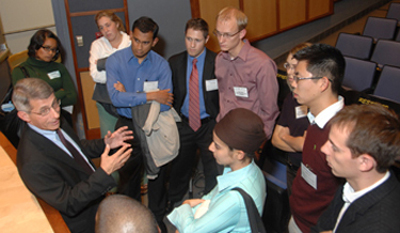 |
|
NIAID Director Dr. Anthony Fauci, who gave the keynote address at the fifth CIST forum, answers student questions after his lecture.
|
Approximately 275 medical and dental students from across the country recently attended the fifth annual Clinical Investigator Student Trainee (CIST) Forum at NIH. The forum is designed for students who are participating in clinical and research fellowships at academic medical centers and NIH and is structured to further engage and encourage them as they become the next generation of clinician-scientists. The two-day event included presentations by well-known researchers from inside and outside the NIH and gave students the opportunity to network with their peers and with established clinical investigators.
This year the program expanded by inviting medical student fellows from the Centers for Disease Control and Prevention Applied Epidemiology Program, the NIH M.D./Ph.D. Partnership Training Program, and institutions that have received NIH Clinical and Translational Science Awards.
"You are the future physician scientists," Dr. Michael Gottesman, NIH deputy director for intramural research, said in his welcome to the group. "We invited you here so we could get to know you and have you get to know us and each other. The people sitting next to you will review your papers and your grants and give you comments, so it’s important for you to begin creating networks now." Dr. John I. Gallin, CC director, invited the students to tour the CC, "a gift that you as taxpayers and future clinical researchers, have all given to yourselves." The group observed some of the translational research and patient care activities throughout the hospital.
Minutes into the forum, students were learning about recent advances in international and global health research from prominent scientists, including Dr. Roger Glass, director of the Fogarty International Center; Dr. Christopher Plowe, professor at the University of Maryland School of Medicine; and Dr. Bruce Walker, professor at Harvard Medical School and director of the Partners AIDS Research Center at Massachusetts General Hospital.
In addition to sharing research insights, many of the presenters described how their careers progressed, noting that their original interests often were significantly different from their final professional focuses. Glass, who worked to create the first rotavirus vaccine, began his career fascinated by the cholera epidemic. He advised the students to find a good mentor and identify a health problem that engages their interest enough to provide a life path. Plowe’s journey specializing in antimalarial drug resistance in Africa began with a stirring public health lecture during medical school. Walker was convinced he wanted to become a family physician and had a bad experience with a clinical research project as a trainee. Observing his mentors working with HIV/AIDS patients when the disease was newly identified launched Walker back into the laboratory and his career as an infectious disease physician.
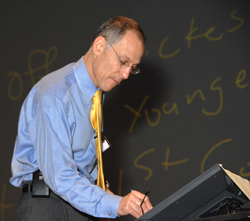 |
|
Dr. Ezekiel Emanuel, chair of the CC Department of Bioethics, led an interactive session on controversies in medicine and bioethics.
| Later that afternoon, Dr. Ezekiel Emanuel, chair of the CC Department of Bioethics, led an interactive session on controversies in medicine and bioethics, such as the allocation of scarce resources like organ transplants or avian flu vaccines during a pandemic. With an electronic board projected behind him, Emanuel solicited and recorded student suggestions on how they would allocate vaccines and hospital beds and what they would do if serving on an institutional review board for an asthma protocol. Although these might seem like abstract ethical issues, Emanuel reminded the students that as future hospital and health-care leaders, they will be in senior positions that will require making these difficult decisions and explaining the moral strategies behind them to the public.
The highlight of the program was a keynote address by NIAID Director Dr. Anthony Fauci, who reflected not only on emerging and re-emerging diseases, but also on his career prior to and at NIH. Fauci said his undergraduate studies of the humanities including Greek philosophy, Latin, and French—with the minimum amount of pre-medical school courses—influenced how he thought about diseases and global health issues. Fauci was also absolutely convinced that he wanted to return to New York to practice, until a Marine captain came to his fourth year medical school class and gave them all a choice of military service branches, including the Public Health Service. This brought him to NIH before the discovery of HIV/AIDS, the disease that would define his career. "Never in my wildest dreams would I have thought I would later be working for presidents and Congress," Fauci said.
According to Fauci, the "extraordinary payback" in scientific understanding, new treatments, and lives saved as a result of the funding and focus dedicated to HIV/AIDS is an excellent example of what is possible with a great investment in clinical research. He noted that there are currently 25 FDA-approved drugs for HIV/AIDS—more than the sum total of drugs for every other viral disease combined. Fauci asked, "If we put the money and focus into HIV/AIDS research, why can’t we put it into other infectious diseases?"
 |
|
The breaks between presentations provided opportunities for students to get to know each other and share research interests.
| In response to a student’s question about how they as future clinical researchers can ensure that translational medicine discoveries reach the people who need them most, Fauci advised that the student think beyond just publishing the next prestigious paper. "It takes a collective commitment from the scientific community. No one individual scientist can conduct the basic research, develop a useable product for people, and deliver it to those who really need it. At some point, you have to collaborate with colleagues in the biotechnology and pharmaceutical industries, but as those making the discoveries, you can have a say in how the treatments based on those advances are used."
Additional panels included updates in cardiovascular diseases, moderated by Dana Boyd, executive director of the Sarnoff Cardiovascular Research Foundation; practical tips for career development, including funding support, grants, and loan repayment, moderated by Gallin; and how to succeed as a physician scientist, moderated by Dr. Frederick P. Ognibene, director of the CC Office of Clinical Research Training and Medical Education and the lead organizer of this annual event.
2007 CIST Forum participants included Howard Hughes Medical Institute-NIH Research Scholars and Fellows, Doris Duke Clinical Research Program Fellows, Fogarty International Clinical Research Scholars, National Center for Research Resources Clinical and Translational Science Award-sponsored students, NIH CRTP Fellows, Sarnoff Cardiovascular Research Foundation Fellows, CDC Applied Epidemiology Fellows, Fogarty International Clinical Research Scholars, and the NIH M.D./Ph.D. Partnership Training Program Fellows.
Back to Top
Gene therapy brings hope to young CC isolation room patient
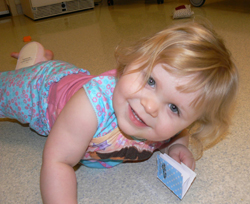 |
|
Katlyn Demarchant plays on the floor of her CC isolation room, where she learned to walk.
|
by Jenny Haliski
Imagine beginning your life not being able to go outside, interact with other people, or have skin-to-skin contact with anyone, including your own family. That’s the life that Clinical Center patient Katlyn Demerchant is soon going to leave behind. She has not lived outside a hospital isolation room that protects her from infections since she was six months old.
That’s when she was diagnosed with adenosine deaminase (ADA) deficient severe combined immunodeficiency (SCID). ADA-SCID is an extremely rare condition where there is a defect in the ADA gene, which is responsible for recycling the chemicals that result from the turnover of the cell’s genetic material. Katlyn, now almost 2, lacks that recycling system so the chemicals accumulate and are transformed into toxic metabolites that kill off her lymphocytes, leaving her with virtually no immune system and vulnerable to frequent, severe infections. If undetected and untreated, SCID typically leads to death before the baby’s first birthday. SCID is often called "bubble boy disease" after it became widely known during the 1970s and 1980s, when David Vetter, a boy with X-linked SCID, lived for 12 years in a plastic, germ-free bubble.
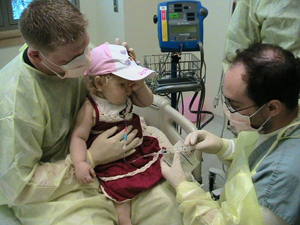 |
|
Katlyn’s dad, Johnathan Demerchant, holds her while NHGRI’s Dr. Robert Sokolic delivers the gene transfer therapy, in which a normal ADA gene is inserted into her stem cells in an attempt to correct the underlying cause of disease.
|
Katlyn and her parents, Daisy Gallant and Johnathan Demerchant, came to the U.S. and the Clinical Center from New Brunswick, Canada, on April 16 to participate in an NHGRI gene therapy protocol conducted by Dr. Fabio Candotti. Stem cells were collected from Katlyn’s bone marrow, a normal human ADA gene was inserted, and the cells were given back to Katlyn. She will return to the CC once a month for at least six months after this first visit and also come back here for much of her life so researchers can evaluate the long-term effects of therapy. Her parents chose to participate in clinical research rather than the other option for Katlyn, a bone marrow transplant. Fewer than 30 people across the world have received this gene therapy for ADA-SCID.
Katlyn is the second child to receive this particular treatment at the CC, but she’s had a lot of other firsts here. Most importantly, her parents feel that for the first time, they are actively helping her get better instead of just keeping her safe and protecting her from getting sick. Because her family and staff wear booties, face masks, rubber gloves, and gowns in Katlyn’s room to keep everything around her clean, she learned to walk on the floor of her CC room, rather than being confined to a small plastic mat as she has been during previous hospitalizations. And thanks to the CC’s Caring Canine visits through the Rehabilitation Medicine Department, Katlyn saw and recognized a dog for the first time, just as she was learning about animals.
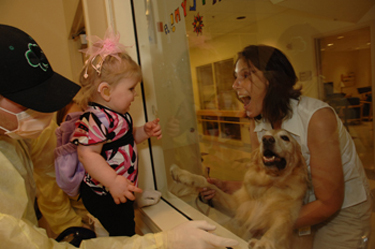 |
|
CC Caring Canine volunteer Renee Leiberman and her dog Toffee visit Katlyn and her dad, Johnathan.
|
Animal-assisted therapy is one program offered to young patients and their families that could be adapted for Katlyn, who is unable to enjoy the play rooms, recreational therapy outings, or any of the fun provided at the Children’s Inn, where her parents are staying. Katlyn’s mom describes her as a very good-spirited and happy little girl, but she gets even more excited when she sees animals, such as the birds outside her first floor window, or Toffee, volunteer Renee Leiberman’s visiting canine.
"Her face completely changes when she sees that dog. Even that little bit of normalcy for her is wonderful," Gallant said. "She said ‘dog, dog, dog’ when she saw her, and even later when she looks at pictures of her." Katlyn banged on her window to get Toffee’s attention and put her hand up to the glass to touch her paw. Leiberman said it was "an unbelievable moment" that "put everything into perspective" for her. "Toffee and I became a pet therapy team to be able to give back, and it has helped put things in perspective when you’re visiting others who are not well. I feel privileged to have given joy to a patient at NIH because, truly, in the end, it’s not about us." Leiberman wanted to volunteer at NIH because of the "incredible work the Clinical Center does, and the outstanding support the Caring Canine program provides to the patients throughout the hospital."
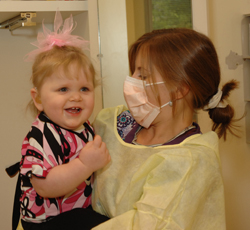 |
|
1NW clinical research nurse Jean Perrelli holds Katlyn.
|
Katlyn and her family will also miss the CC staff with whom they’ve connected during their six months here. In particular, Gallant appreciated how 1NW clinical research nurse Jean Perrelli "went above and beyond" to take time to play with Katlyn since her first days at the CC. Perrelli said being part of the care team for patients such as Katlyn who are responding to new therapies is a bright spot in working with very sick children. "If a therapy doesn’t work, I remember that maybe 10 years down the road, what I did today will help researchers learn and help another child. But if the research works for someone today, it’s great," Perrelli said, adding that she’ll miss hearing Katlyn yell, "Hiya, Jean!" to her through her window.
Gallant feels that coming to the CC to participate in clinical research was the right choice, as well as a lucky one. She’s found more than 30 four-leaf clovers on the grounds around the CC and the Children’s Inn during her stay, and they’re taped up on Katlyn’s window for good luck. "It’s very scary as parents to have a sick child with a rare disease. We’re helping the Clinical Center and NHGRI get the data they need to offer this therapy to other parents with kids in this situation and to help people in the future. I know it will be very special to Katlyn to be able to say, ‘I helped with that,’ years from now," Gallant said.
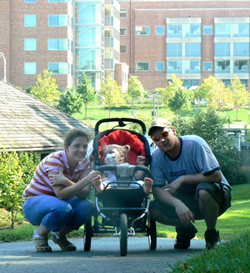 |
|
In September, a few weeks before Katlyn left the CC, her neutrophil counts were high enough for her parents to take her outside to explore the world around her for the first time in a year. "We thought we owed it to her because we had no idea when she’d be able to do it again. We have no idea what the next months will bring," Gallant said.
|
Their CC experience also provided a safe space for them to learn and practice the new techniques they’ll need to care for Katlyn when she goes home, such as checking her vital signs, changing her dressings, and flushing her IV medications. Despite the unusual precautions they’ve taken—Gallant says it will probably feel wrong to hold Katlyn without gloves at first—they’d rather err on the side of caution. "Katlyn will have the rest of her life to look forward to. She’s spending this small amount of time here to be able to have a more normal rest of her life," Gallant said.
Her family also connected with other families with ADA-SCID and other rare diseases, many of whom ask Gallant questions about her experiences or visit her blog for ideas on what to do when their child is diagnosed. "When your child is diagnosed with a rare disease, there’s often not a large network you can go to for support, as you could with more common illnesses. There was a family in Australia who decided to enroll in a gene therapy trial after reading Katlyn’s blog," Gallant says.
About 180 days after her May gene therapy transplant, Katlyn’s neutrophil and lymphocyte counts reached levels stable and high enough for her to return to her Canadian hospital in Nova Scotia. Katlyn left the CC on a private LifeFlight plane and wearing a mask as she arrived. The trip back to Canada couldn’t come soon enough for her and her family: Katlyn was starting to slide her foot through the door to her room when it opened and just learned how to say, "home."
Back to Top
Special procedures IV placement nurses have the magic touch
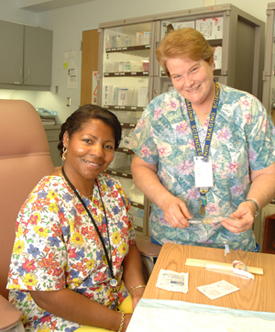 |
|
Monica Blackledge (left) and Sue Freeman, IV placement nurses in the CC Diagnostic Radiology Department’s Special Procedures Section.
|
Nurse specialist Sue Freeman knows how to start an IV line. She’s worked with the devices for all 30 years of her career and her specialty is starting contrast IVs for radiology patients receiving CT or MRI scans.
"Starting IVs is a skill," Freeman said. "There’s a touch to feeling the deeper veins and a bunch of tricks you need to know. Patients expect you to be fast and good." Freeman has to be fast to keep up with the steady stream of patients she encounters at the Clinical Center: On an average day, she will start 40-50 IVs. Freeman came to NIH in 1994 as a clinical nurse on the 2NE immunotherapy unit, then went to NCI’s Dr. Steven Rosenberg’s lab as an apheresis nurse specialist and finally to the Diagnostic Radiology Department’s special procedures section five years ago.
On not-so-average days, Freeman’s outstanding customer service and expertise really shine through, according to George Altizer, the nurse manager for her team. He recalls how during the ice storm last winter, Freeman noticed when she arrived that no one had reached the CT admissions desk yet because of the difficult driving conditions. Freeman took over for missing staff, answering phones, releasing orders for pending CT scans, organizing and assembling patient screening worksheets, reviewing patient data for lab values and allergy histories, and reassuring waiting patients—all while continuing her assigned job of placing IVs for those who needed them.
Altizer calls Freeman an IV expert. Karen Adams, program coordinator for the NICHD’s program for pheochromocytoma, agrees. "The patients love her and she’s really a superb nurse. Sue goes out of her way to help people and will stop what she’s doing to jump in and assist."
In fact, Freeman’s IV work was also pinch-hitting for the department until they could hire and train Monica Blackledge as the permanent IV nurse. According to Altizer, Freeman continues to practice in the department and remains available for IV access device consult as needed. Blackledge, who comes to NIH by way of the Pentagon DiLorenzo Tricare Health Clinic and National Naval Medical Center, said she takes pride in everything she does and "loves working here at the House of Hope."
Back to Top
CFO leaves to serve American Cancer Society
 |
|
Departing CC CFO Lisa Lacasse
|
Lisa Lacasse, chief financial officer for the since 2003, left on Nov. 29 to become vice president for operations and strategic integration at the American Cancer Society’s Cancer Action Network.
The network is a not-for-profit, non-partisan advocacy organization dedicated to eliminating cancer as a major public health problem through federal and state voter education and issue campaigns aimed at influencing candidates and lawmakers to support laws and policies that will help people fight cancer. Lacasse’s new role, which will be based in Washington, D.C., will include both financial and research advocacy responsibilities.
"Lisa has done a remarkable job as the CC's chief financial officer and has led many important initiatives for the organization," said Dr. John I. Gallin, CC director. "Her enthusiasm, expertise, and contributions have enhanced our ability to operative effectively and efficiently."
During her tenure, Lacasse oversaw the planning, formulation, and execution of the CC's $345 million annual budget. Working with the Office of Financial Resource Management (OFRM), Lacasse’s accomplishments include introducing the first electronic executive information system that provides real-time census data by institute, branch, principal investigator, and protocol; re-launching operational reviews of CC departments; managing multiple cost containment projects; and leading several CC strategic initiatives, including a 2005 feasibility study on third party reimbursement, a 2006 benchmarking and analysis report, and the on-going data transformation initiative.
In 1999 Lacasse joined the CC as special assistant to the director, led the development of computerized protocol mapping, and served on the project management team for CRIS.
She received a 2007 NIH Director’s Award for outstanding management of the CC budget during a period of increased demands and constrained fiscal resources, a 2004 Special Act/Service Award for activation of the new hospital and a 2002 CC Director’s Award for outstanding leadership in improving collaborative management of the CC budget process.
Dan Rinehuls, chief of the Office of Financial Resource Management and deputy CFO, will serve as acting CFO.
Back to Top
Twelve Housekeeping and Fabric Care employees retire in 2007
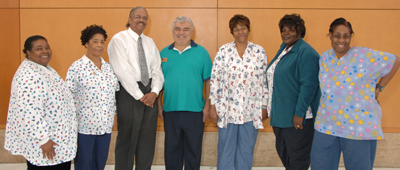 |
|
Retiring as of Dec. 31 (from left): Velma Lawson, 35 years; Edith Bauvil, 17 years; Lucius Stewart, 31 years; Ramón Rodríguez, 36 years; Ida Toller, 17 years; Geraldine Pounds, 17 years; and Laverne Patterson, 20 years.
Not pictured: Nona Conway, retired Oct. 26 after 35 years; Barbara Hardie-Welch, retired Aug. 31 after 37 years; Alice Minor, retired Aug. 3 after 18 years; Cora Sherrod, retiring Dec. 31 after 24 years; and John Smith, retired Aug. 31 after 18 years.
|
Twelve Clinical Center Housekeeping and Fabric Care Department (HFCD) employees retired in the fall and winter of 2007, many with more than 20 years of service to the hospital.
HFCD Chief Rob Mekelburg said the department is very proud of its employees and "their impressive years of service and devotion" to the CC. "I feel very fortunate to have worked with this group of people and will will miss their contribution to the department's mission. These are folks who truly care about what happens here and understand their value to research and patient care."
Back to Top
NIH nurse practitioners organize first poster day
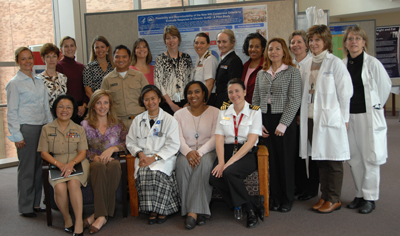 |
|
(standing, from left): Wendy Henderson, NINR; Susan Rudy, NIDCD; Irene Dustin, NINDS; Joan Ohayon, NINDS; Leo Saligan, NINR; Shelia Brady, NICHD; Julia Purdy, NCI; Michelle Braun, NIDDK; Shelia Mahoney, NICHD; Pamela Brooks, NIDDK; Margarita Velarde, NCI; Linda Bartlett, NIDDK; Joanne Forbes, NIDDK; and Sara Plehn, NIAMS.
(seated, from left): Vien Vanderhoof, NICHD; Dawn Wallerstedt, NCCAM; Maria Ferraris Araneta, NIMH; Wendy Blocker, NICHD; and Victoria Anderson, NIAID.
| Nurse practitioners (NPs) working at NIH across 15 ICs joined together to organize their first poster session on Nov. 13 in celebration of National Nurse Practitioner Week.
NPs are licensed independent practitioners who work in a variety of settings as primary or specialty care providers, both autonomously and in collaboration with other health-care professionals. NIH's NPs also play a critical role in clinical research within the intramural program through the care they provide to patients participating in protocols at the Clinical Center.
About 10 NIH NPs presented posters on their involvement in clinical research with topics ranging from strategies for recruitment of minority women for clinical trials to the use of opiods for pain management.
NCI hired the first NIH NPs in the 1980s to care for patients enrolled in pediatric oncology and HIV clinical trials. The number of NIH NPs has since grown from seven in 1993 to nearly 100 in 2007.
In a recent survey of NIH NPs to document how their role here differs from NPs in the community who work in predominantly clinical settings, 42 percent of respondents said they work at NIH because of their interest in an environment that combined patient care and clinical research.
Back to Top
CC CFC gift basket raffle raises almost $5,000 in charitable donations
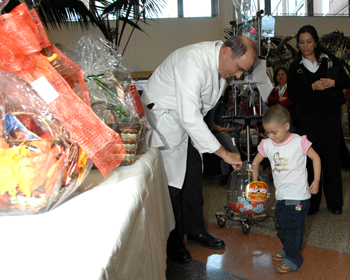 |
|
CC patient Madelen Hernandez helpes CC Director Dr. John I. Gallin select the winning raffle tickets.
|
The Clinical Center's Combined Federal Campaign gift basket raffle on Nov. 29 in the Hatfield atrium raised almost $5,000 in charitable donations. The 19 baskets, created and submitted by CC departments, ranged in value from $35 to $350.
 |
|
Vernessa Gibson from 7SW shakes the raffle tickets in preparation for the drawing.
|
The top five baskets receiving the highest bids include:
Stress Relief, Office of Administrative Management, $801;
Picture That, Medical Record Department, $756;
Lottery, Department of Laboratory Medicine, $611; and—tied for fourth place—
Pamper Yourself, Nursing; and Baker's Basket, Office of Communications, Patient Recruitment, and Public Liaison, $411 each.
Back to Top
Singers fill atrium with holiday cheer
 |
(from left): Sweet Inspiration Singers Judie Tucker, Donna Walters, and Lisa Orton perform holiday music in the CC atrium. The trio has been together for six years.
|
The harmonies of the Sweet Inspiration Singers filled the Clinical Center's atrium on Dec. 3.
Singer Judie Tucker, who is a regular donor to the NIH blood bank and participated as a healthy volunteer in a procol at the CC for Alzheimer's research, said the concert is a way of sharing with others. "If you're given a gift, you should share it with those around you."
Upcoming holiday events sponsored by the Rehabilitation Medicine Department's recreation therapy section include a holidays around the world party on Dec. 13 at 6:30 pm on the 1SE patio, a trip to the National Christmas Tree on Dec. 17 at 6:30 pm, a Washington Chorus concert on Dec. 20 at 7 pm in the atrium, and Christmas Eve caroling at 6:30 pm.
Back to Top
News Briefs
Pharmacy Department celebrates hospital, health-system pharmacy week
 |
|
The magnet distributed by the pharmacy department.
| Hospital and Health-System Pharmacy Week in October recognized the contributions made by pharmacists, pharmacy technicians, and support staff in advancing the successful use of complex medications. CC pharmacy staff participated in the 2007 celebration, which included a kick-off breakfast, a potluck lunch, and contests, such as guessing the number of "pills"—really M&Ms—in a jar. Posters with pharmacy staff photos brightened the outpatient pharmacy waiting room and pick-up window. Staff also distributed magnets with a toll-free contact number and the words, "NIH Pharmacy…We Care!"
CC staff sweep AMSUS pharmacy awards for 2007
Two members of the Clinical Center Pharmacy Department received both of the 2007 pharmacy awards given on Nov. 14 by the Association of Military Surgeons of the United States (AMSUS), which acknowledges the abilities of outstanding federal health-care individuals each year through its awards program. Dr. Karim Anton Calis, who directs the department’s Drug Information Service and is a clinical specialist for endocrinology and women’s health, received the Andrew Craigie Award. Named after the first U.S. Apothecary General who served under General George Washington during the Revolutionary War, the award is presented to an individual for a career of outstanding accomplishment in the advancement of professional pharmacy within the federal government. Dr. Frank Pucino, clinical pharmacy specialist for ambulatory care, received the AMSUS award for excellence in clinical pharmacy practice. The award recognizes the leadership role of federal pharmacists in the transformation of pharmacy practice by working closely with other health-care providers to use pharmacotherapies in a safe, effective, and cost-efficient manner.
CC microbiology chief receives Pasteur Lecture Award
Patrick Murray, chief of microbiology, Department of Laboratory Medicine, has received the Pasteur Lecture Award from the Illinois Branch of the American Society for Microbiology (ASM). The Pasteur Award was established in 1948 to publicly recognize individuals who have made significant and outstanding contributions in the field of microbiology. ASM is the oldest and largest life science organization in the world and currently has more than 43,000 members.
Romano elected to of Medical Informatics
Rear Adm. Carol Romano, assistant surgeon general, chief nurse officer in the U.S. Public Health Service, and senior advisor for clinical research informatics in the CC's Department of Clinical Research Informatics, has been elected into the American of Medical Informatics (ACMI). ACMI is an international college of elected fellows who have made significant and sustained contributions to the field of medical informatics. Incorporated in 1984, the organization now includes almost 300 members.
World AIDS Day photo exhibit
A photography exhibit, "Hands for Life/Hands of Hope," commemorating World AIDS Day 2007 is on display in the first floor east corridor near the atrium. NIAID Director Dr. Anthony Fauci opened the exhibit Dec. 1. It will be on display until Jan. 15.
Back to Top
New clinical research protocols
The following new clinical research protocols were approved in October:
Insulin Resistance and Atherosclerosis in a Sample of Women with Systemic Lupus Erythematosus, 08-AR-0008, Kathleen M. Coyle, MD, NIAMS
A Phase I Study of Ipilimumab (Anti0CTLA-4) in Children, Adolescents, and Young Adults with Treatment Refractory Cancer, 08-C-0007, Crystal L. Mackall, MD, NCI
Multiple Ascending Dose (MAD) Phase I Study of the IGF-1R Antagonist R1507 Administered as an Intravenous Infusion in Children and Adolescents with Advanced Solid Tumors, 08-C-0010, Frank M. Balis, MD, NCI
A Phase II Trial of Enzastaurin (LY317615) in Combination with Bevacizumab in Adults with Recurrent Malignant Gliomas, 08-C-0015, Howard A. Fine, MD, NCI
Calibration of Non-Invasive Non-ionizing Imaging Techniques to Study Vasculature of Healthy Volunteers, 08-CH-0001, Amir Gandjbakhche, PhD, NICHD
High Throughput Screening of Compound Libraries to Discover a Drug for the Treatment of Sickle Cell Disease, 08-DK-0004, William A. Eaton, MD, NIDDK
An Open Label, Sequential Cohort Dose Escalation Study to Evaluate the Safety and Efficacy of AMG 531 in Thrombocytopenic Subjects with Low or Intermediate-1 Risk Myelodysplastic Syndrome (MDS), 08-H-0009, Cynthia E. Dunbar, MD, NHLBI
Effect of Fasting on the Size of Lymphangioleiomyomas in Patients with Lymphangioleiomyomatosis, 08-H-0016, Angelo M. Taveira-DaSilva, MD, NHLBI
Randomized, Double-Blinded, Placebo Controlled Study of the Effects of Atomoxetine on Cognitive Function in Patients with Schizophrenia and Normal Controls Based on COMT Genotype, 08-M-0002, Jose A. Apud, MD, NIMH
PET Imaging of Peripheral Benzodiazepine Receptors in Patients with Carotid Atherosclerosis, 08-M-0006,Masahiro Fujita, MD, NIMH
L-Dihydroxyphenylserine (L-DOPS) for Norepinephrine Deficiency: Interactions with Carbidopa and Entacapone, 08-N-0012, David S. Goldstein, MD, NINDS
Back to Top
Upcoming Events
December 5, 2007
Ethics Rounds
When Respecting Confidentiality Is Risky
Leonard Fleck, Ph.D., Professor of Philosophy and Medical Ethics
Philosophy Department and Center for Ethics and Humanities in the Life Sciences
College of Arts and Letters/College of Human Medicine
Michigan State University
Lecture will be videocast, http://videocast.nih.gov
December 12, 2007
Contemporary Clinical Medicine: Great Teachers
Anemia: Mechanistic Considerations
William Zinkham, M.D.
Distinguished Service Professor, Emeritus
Johns Hopkins School of Medicine
Lecture will be videocast, http://videocast.nih.gov
December 14, 2007
Annual Clinical Center Director’s Awards Ceremony
Masur Auditorium
1-3 p.m.
December 19, 2007
Nephrogenic Systemic Fibrosis: Which of Your Patients Are at Risk?
Meryl Waldman, M.D.
Senior Clinical Research Fellow, Kidney Disease Section, NIDDK
Nephrogenic Systemic Fibrosis: Association with Gadolinium-Based MRI Contrast Agents and Recommendations to Mitigate Risk
Elizabeth Jones, M.D., M.P.H.
Acting Chief, Clinical Operations, Diagnostic Radiology Department, CC
December 26, 2007
No Grand Rounds.
Back to Top
Clinical Center News, National
Institutes of Health, Building 10, 10 Center Drive, Room 12C440, Bethesda, MD 20892-1504. Tel: 301-496-6787.
Fax: 301-402-2984. Published monthly for CC employees
by the Office of Communications, Patient Recruitment, and Public Liaison. News, article ideas,
calendar events, letters, and photographs are welcome.
Back to Top
|
|


 The information on this page is archived and provided for reference purposes only.
The information on this page is archived and provided for reference purposes only.